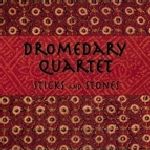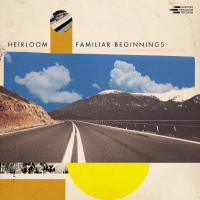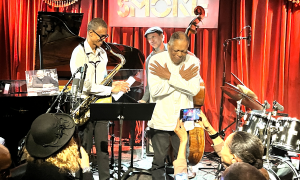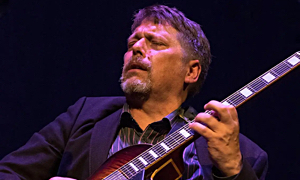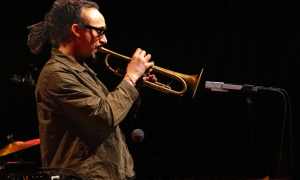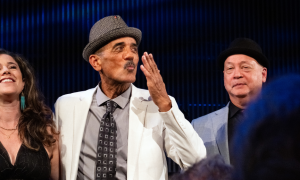Home » Jazz Articles » Live Review » Festival International Musique Actuelle Victoriaville: D...
Festival International Musique Actuelle Victoriaville: Day 3 - May 17, 2008
Houle, Smulovitz, Gagnon & Griffiths / Baumann & Ziegler / Spunk
Festival International Musique Actuelle Victoriaville
Victoriaville, Quebec, Canada
May 16, 2008
Perhaps the most malleable of musical instruments is the human voice. With the innovations of singers including Meredith Monk, Sidsel Endresen and Maja Ratkje (who performed with Norwegian free improvisers Spunk on day three of FIMAV 2008), the potential of the voice has expanded beyond traditional concepts of melody into the area of texture. Shaped like any other instrument with modern processing and sampling, what's become increasingly evident is just how much a single voice can also achieve, without any added effects whatsoever.
Day three of Festival International Musique Actuelle Victoriaville celebrated just how far the human voice could be stretched in a variety of musical contexts. From multidisciplinary presentations to cybergloves and focused, well-shaped free improvisation, FIMAV once again proved itself to be a festival whose preferred position is on the bleeding edge, with a series of shows that were as eye—and ear-opening as it gets.
Vivane Houle/Stefan Smulovitz/Noam Gagnon/Jamie Griffiths
In some ways, FIMAV is a Canadian cousin to Norway's Punkt Festival in its multidisciplinary approach to music and improvisation. For the first show of the day at Cinema Laurier, FIMAV brought singer Viviane Houle, computer music specialist/violist Stefan Smulovitz, dancer Noam Gagnon and video artist Jamie Griffiths together for a multimedia performance that demonstrated the very real potential for integration of multiple artistic disciplines into a cogent whole.Houle, a singer with an operatic background and remarkable range, began the show by using her voice to create odd guttural sounds, rapid untranslatable articulations and high-pitched squeals that gradually shifted towards melody as Griffiths' series of words, coalescing on the large video screen, but so fleetingly that, at first, it was impossible to make them out. The words ultimately, remained onscreen long enough to drive Houle's vocals towards use of the very same words as a starting point to evolve her improvised lyrics even further. As Smulovitz's soundscapes shifted between noise and melody, responding to Houle while providing further impetus to move the entire process in other directions.
Gagnon's dance was more than stage movement interpretation. With a video camera onstage controlled by Griffiths, he was not only seen "in the flesh" and in real time, but onscreen as well, often significantly manipulated visually. He also became a direct part of the video through use of a keyboard, where he typed words that appeared on the video screen and which Houle used as yet another jumping off point. Later in the performance he used an electronic device that created electronic percussive sounds, grabbed by Smulovitz, processed and fed back.
Smulovitz also sampled Houle's voice, at times creating layers that resulted in a virtual choir. He played viola at various points, providing another thematic/textural foil for Houle. Houle also became part of the visual presentation at times, interacting directly with Gagnon, at one point huddled intimately center stage with him as the two sang into the microphone.
While the show began in abstraction and angularity, there were many moments of beauty to be found within the hour-long performance. Deftly and seamlessly integrating visual arts, dance and music, Houle, Smulovitz, Gagnon and Griffiths delivered a performance that set the tone for what was to come during the rest of the day's events.
Franziska Baumann/Matthias Ziegler
With an array of flutes that rivaled Anthony Braxton's big horns from his Diamond Curtain Wall performance at FIMAV 2007, Matthias Ziegler and vocalist Franziska Baumann delivered their own brand of electroacoustic free improvisation. The two Swiss artists incorporate elements of the jazz tradition through Baumann's occasional scat-like delivery; but it was Ziegler's processed flutes and Baumann's unique approach to expanding her vocal palette that made their late afternoon performance at CEGEP thoroughly compelling.Baumann possesses a voice with a remarkable range, and an ability to acoustically stretch its potential through multiple extended techniques, and that would have been enough to make the show a must-see. Her use of a cyberglove—a glove literally wired up to a computer, allowing her to massage her acoustic instrument through use of buttons (some on a sense that she occasionally attached to her microphone) and arm and hand movements—allowed her to take the music to completely unexpected places. Live sampling is, of course, nothing new, but by allowing her to alter her voice in a very physical way, and coupled with Ziegler's rarely seen bass and contrabass flutes, Baumann was able to turn the performance into another that was as intriguing to watch as it was to hear.
Baumann's extended techniques were matched by Ziegler, who found ways to turn his various flutes into percussive instruments. While much of the performance was in the rarified arena of ethereal atmospherics, pieces like the performance's finale actually grooved. With Baumann sampling her own voice, harmonizing it and creating oscillating shifts, she created (like Houle earlier in the day) a virtual choir that was supported by Ziegler's creation of noise-like textures and rich harmonies of his own.
A relatively new partnership documented on the very aptly titled Voices and Tides (Leo, 2007), Baumann and Ziegler's performance was their first in North America. FIMAV distinguishes itself with its many Canadian and North American firsts, as well as some shows, like the world premier Art Bears Songbook performance that will close the festival on Monday, May 21—one more reason why the festival engenders such passionate loyalty amongst its fans.
Spunk
Free improvisation takes on many complexions, but amongst Norwegian groups like Supersilent and even the more extreme Ultralyd find ways to incorporate surprising beauty amongst greater extremes. The same goes for Rune Grammofon label-mates Spunk, an all-female collective that brings together unique instrumentation, a playfulness that transcends what is all-too-often far too serious music, and an ability to shape extended spontaneous creation (in the case of their FIMAV performance, an hour-long continuous set) into a moving stream-of-consciousness narrative.Trumpeter Kristin Andersen (who also played recorder during portions of the performance) and cellist Lene Grenager are both strictly acoustic musicians though, with the variety of extended techniques both employ, they take their instruments to unexpected sonic territories. Grenager was particularly notable in her almost relentless pulse early on, a persistent harsh bowing that created a rhythmic foundation for a group that has no conventional rhythm instruments. She also created intense waves of sound, her left hand moving so fast at times as to be nearly invisible, while her right hand bowed the strings with across the entire dynamic spectrum.
Hild Sofie Tafjord's French horn gives Spunk a distinct complexion; again, extended techniques created far broader textures than normally heard, not to mention that her horn is rarely heard in improvised settings. But as the more jagged abstraction of the opening part of the set gave way to greater space, it was Tafjord who created some of the loveliest melodies. With a twelve-year history, Spunk has evolved a deep chemistry, with Tafjord and Andersen often coming together in ways that might, under any other circumstances, be thought of as preplanned, making their spontaneous an in-the-moment interaction all the more remarkable.
Singer Maja Ratkje, known to ECM fans for her work on albums including accordionist Frode Haltli's Passing Images (ECM, 2007), is also a renowned composer of contemporary classical composition. Here, however, with no roadmap whatsoever, her voice—another example of expanding a traditionally melodic instrument to more unpredictable places that included rapid-fire articulations, guttural gestures and sonics covering a surprisingly broad range---became another expansive part of Spunk's collective aural landscapes: at times harsh and aggressive; at other times fragile, vulnerable and painfully beautiful. Ratkje also brought a collection of toys, tape recorders, other found sound objects and a theremin which she employed, sampled, processed and fed into Spunk's soundscape with, at times, almost mischievous glee. This was a group that not only created distinctive and profound music, but clearly had fun while doing it.
In addition to Ratkje's sonic manipulations, Tafjord also utilized electronics to expand the landscape. Spunk was capable of creating powerfully dense and challenging music; but so, too, was it capable of haunting lyricism and elegant simplicity. All too often free improvisation eschews melodism, and equally all too often fans seem to believe that discernible melody has no part in it. But the best music, as in the best lives, is all about confluence and contrast; pain and pleasure; harsh and beautiful. Spunk manages to bring together all these elements, making their performance one of the highlights of FIMAV 2008 and, quite possibly, the best show of the festival.
Tomorrow: Nick Didkovsky, Gottschalk/Fengxia, Roscoe Mitchell and the Note Factory.
Tags
PREVIOUS / NEXT
Support All About Jazz
 All About Jazz has been a pillar of jazz since 1995, championing it as an art form and, more importantly, supporting the musicians who make it. Our enduring commitment has made "AAJ" one of the most culturally important websites of its kind, read by hundreds of thousands of fans, musicians and industry figures every month.
All About Jazz has been a pillar of jazz since 1995, championing it as an art form and, more importantly, supporting the musicians who make it. Our enduring commitment has made "AAJ" one of the most culturally important websites of its kind, read by hundreds of thousands of fans, musicians and industry figures every month.



